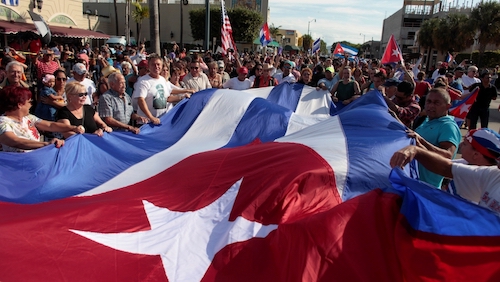
I received a surprising amount of feedback following a piece titled How Not to be a Douchebag to Cuban-Americans. Much of it was fantastic. Thousands commented on how they related to my frustrations. However, a sizeable portion of the responses were (unsurprisingly, given the Laws of the Internet) negative, sometimes violently so. The bifurcated nature of the reactions got the bilingual hamster in my head running just a bit faster.
Readers either loved or hated my work. Granted, I wrote the thing in an hour as a cathartic release of years of accumulated aggravation, not a comprehensive essay explaining Cuban-Americans to the rest of the world. As such, it was primarily meant for a Cuban-American audience. Nevertheless, I was disappointed to see practically no meaningful discussion blossom between Cuban-Americans and individuals who had (I hope, inadvertently) insulted them in the past.
So, I decided to allow my blood pressure to drop to a less alarming level, step away from the bile that fueled my previous piece, and hopefully write something that might catalyze conversation, rather than simply act as another Internet rant. This article is therefore directed at those 317 million other individuals in the U.S. who are not Cuban-American, but might curious to learn about us.
We form a community that, though it may appear united in behavior and outlook to outsiders, is actually a complex tangle of contradicting experiences, perspectives, and agendas. There will inevitably be scores of Cuban-Americans who disagree vehemently with some of my assertions—as is their right, since my nomination as the Cuban-American envoy to the United Nations was never confirmed. For a population that only musters 2 million individuals, the community can be mind-boggling complicated. We are divided and stratified into many subdivisions. I will spend the next several paragraphs briefly describing some of them.
Travel to Cuba

This is one of the more contentious topics within the Cuban-American community. It is also far more tangible than theoretical debates about lifting the embargo, given that Cuban-Americans have been intermittently permitted to travel to the island since the 1970s. Nevertheless, we have differing views regarding that travel. The pain of being forced from their homeland made many older Cuban-Americans swear to never return while the Castro regime remained. Others note that some portion of money spent on the island is directed to the Cuban government, which uses it to further oppress its own people. Still, individuals who reached the U.S. after the 1980s tend to be more willing to return to the island to visit family and friends. They are also more amenable to the idea of stronger ties between the U.S. and Cuba. Regardless of their disagreements, both sides wholeheartedly wish to better the lives of those still on the island.
Language

Most Cuban-Americans speak or understand Spanish reasonably well. Nevertheless, many among the second and third generations have significantly reduced language skills compared to those born on the island. In a community that consists of every physical appearance imaginable, a shared language, culture, and history largely define the Cuban-American identity. As a result, many who do not speak Spanish well might feel that they are “not really Cuban.” Some parents purposefully refused to teach them to aid assimilation into American culture. This sometimes engendered a deep sense of loss among those who were not taught Spanish at home, and many attempted to reconnect with their roots as they aged. Some were disinterested in learning Spanish as they grew up and chose to discard that portion of their heritage. Yet, others were raised outside of Latin American communities, and lost the language due to an inability to practice it. Admonishments of not “being Cuban enough” or being a “gringo” are not infrequent. Though the majority of fully bilingual Cuban-Americans wholly accept these peers into the community, many of the latter still feel ashamed when called upon to publicly speak Spanish.
Migration Waves

There have been several waves of Cuban immigrants to the U.S. The largest occurred in the 1960s, 1980s (known as Mariel), and mid-1990s (known as the Balsero Crisis). There has also been a sizeable inflow over the last decade. Each wave was very different from its predecessors. Despite some common experiences, they certainly did not always get along. Marielitos were deprecated as criminals. Balseros were perceived as uneducated. More current arrivals were stigmatized as lazy and “reffy” (a derogatory term derived from “refugee” that signifies a lack of class). These biases are wholly decoupled from reality, and most Cuban-Americans do not hold them. However, they do exist, and though they have subsided over time, they still separate the community.
Socio-Economic Class

Though Cuban-Americans have a higher average income than other Hispanic groups in the U.S., Miami (where most Cuban-Americans live) is one of the country’s most unequal cities. A few have very privileged lives on par with their associates in Southampton. Many fall somewhere in the middle class. Many others struggle to meet their daily needs. All levels of government and local civil society ignore their problems. This willful neglect burdens them with high crime rates, appalling education, and deplorable public services. As a result, there exists a contentious schism between those Cuban-Americans at the top and the much larger base below them.
Race

Cuban-Americans come in all colors and ethnicities imaginable—from ivory white to onyx black and everything in between. Like in the U.S., Cuba’s Black population was enslaved on plantations for centuries. Even when it gained its freedom, it was still subjected to institutionalized discrimination and endemic bigotry, making it much poorer than the White Cuban populace at the time of the 1959 Revolution—a pattern that continues on the island to this day. Some Cuban-Americans contend that no widespread racial prejudice existed in Cuba because Blacks received more social acceptance than their contemporaries in the U.S. However, historical documentation describes the country’s ingrained racism. Many darker Cuban-Americans continue to face difficulties and discrimination in the U.S. and Cuba, even from members of their own communities.
Cultural Conservatism

Cuban-American culture, like that of all other Hispanic groups, tacks conservative because of the Spanish colonial and Catholic history of Latin America. This makes it very difficult for many LGBTQ individuals to come out to their families and live openly, as they risk being shunned or harshly judged. Our culture also has machismatic tendencies. Many, though by no means all, women are expected to live with their parents until they are married, and gender roles can be strictly enforced throughout adulthood.
American Black Community Relations

On a macro level, South Florida’s Cuban-American community does not have good relations with the American Black community. Following Cuban-Americans’ arrival in Miami, most of the American White population moved away due to a frothy mix of impotent fury and racism. Those Cuban-Americans who accumulated wealth and power, along with other affluent Latin Americans, then replaced their antecedents at the top of the socio-economic ladder, though many Hispanics never made it past the lower rungs. That left Miami’s Black population exactly where it started, i.e. the very bottom. This produced a deep resentment against Cuban-Americans, which led to a series a race riots and a recurring cycle of violence. That historical antagonism has negated attempts to foster common ground between the Black population and poorer Cuban-Americans, despite their many shared grievances. Miami’s Black community continues to be ignored by contemporary politicians (who are often wealthier Cuban-Americans), further exacerbating its acrimony.
Hispanic Community Relations

Many Cuban-American leaders do not have the best relations with other Hispanic elites. Upon their arrival on dry U.S. soil, Cuban-Americans were given a very privileged status among immigrant groups. They received automatic asylum because they were fleeing a repressive communist dictatorship at the height of the Cold War, placing them on a path to citizenship that no other Latin Americans were afforded. They then largely abstained from the Chicano Civil Rights Movement. This led to a sense of antipathy between Mexican-Americans, other Hispanics involved in the farm worker movement, and Cuban-Americans. The former saw Cuban-Americans as entitled and disinterested in their plight. Cuban-Americans, for their part, were deeply angered by Chicanos’ use of Leftist rhetoric, iconography (Che Guevara, etc.), and what they perceived as a blatant disregard for all they had lost during Cuba’s Communist Revolution. This does not mean that Cuban-Americans do not get along with other Hispanics. They generally have excellent individual relations. Their respective political elites, however, do not always see eye to eye.
Leftist Iconography

Despite what political pundits may claim, Cuban-Americans do not overwhelmingly vote Republican. In fact, the community is just about split between the two political parties. However, regardless of their personal leanings, most are intensely insulted by images celebrating Che Guevara or Fidel Castro. This has nothing to do with ideology, but everything to do with history. The sanctity or demonization of these two figures has been litigated ad nauseam in countess online fora, so I will not debate it here. Instead, I will simply state that practically every Cuban-American family lost loved ones, property, and livelihoods to the direct and indirect actions of Castro and Guevara. Even seeing their visages publicly lionized causes immediate, involuntary, and intense emotional pain.
Personal Space

Cuban-Americans are a very loud and expressive community. Personal space is reduced compared to overall U.S. norms. Hugs, kisses, and back slaps abound, even among strangers. Though we are no more aggressive than any other group, arguments can turn into a cacophony of bilingual shouting, which may or may not have any relevance to the original point of contention.
Well, it looks like you made your way to the bottom of the article. Congratulations, you just slogged through 1,700 words. That’s no mean feat. I hope you have now absorbed everything there is to know about Cuban-Americans—because I certainly have not. Our community is a Gordian Knot of complexity. This piece only tugs at a few of its strings. To my fellow Cuban-Americans, I know that a number of you will disagree vociferously with some of what I have said. I only aspire to not completely disappoint you in how I have briefly presented our community. To those who did not grow up among our crazy, convoluted, hilarious, and frustrating tribe, I hope I have granted you some perspective into our lives.
If you like our stories, check out our latest book.

